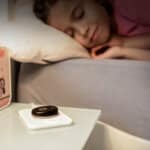Three Dinner Activities to Build Your Child’s Communication Skills

Last week we talked about what “hearing-age-appropriate language” is, and now we’ve got three different activities that you can play with your child around dinner time—each of which is intended to build communication skills for a different hearing age:
- For a Child Beginning to Listen and Speak
- For More Advanced Listeners
- For Expert Listeners and Speakers
1: For a Child Beginning to Listen and Speak
The goal here is to build your child’s awareness of sounds—and attach meaning to simple, routine words and phrases that are used in a sing-songy voice.
- Use different food packages to make noises and draw your child’s attention to the different sounds:
- Tap on the soup can with a spoon then tap on the milk carton or wrinkle the bread wrapping, to show that they make different sounds.
- Make these noises when your child is looking at you as well as when he or she is looking away. Did they recognize there was a sound? If yes, then show them what made the sound, identify the sound they heard, and talk about what it is.
- Point out sounds that the different packages make:
- When you open the soup can, have your child listen to how it “pops”.
- When you pour milk, have your child listen to how it goes “glub glub glub”.
- When you’re cutting bread or cheese, have your child listen to how the knife goes “wap” on the cutting board.
- Match familiar phrases to actions by saying:
- “Open” each time you are about to open a cupboard, refrigerator, can, etc.
- “Hot hot hot”, “Don’t touch”, or “No no no” when getting close to the stove.
- “Round and round and round” when stirring soup.
- “Put it on” when adding cheese or bread to a sandwich.
- “All done” when turning off the stove or other appliances.
- “Ready” when the food preparation is finished.
- “Brrr” when you open the refrigerator.
- When you’ve said these words a few times, try saying the word and seeing if your child tries to complete the action or look to where the action typically occurs.
- Expand on your child’s speech:
- If your child says “oh-eh” when you’re opening something, complete it by saying “I opened the refrigerator”.
- If your child says “ha ha ha” when you’re near the stove, say “Yes, the stove is hot and we never touch it”.
2: For More Advanced Listeners
Once your child is aware of and can discriminate sounds then it’s time to focus on identification: building vocabulary and auditory memory. You can use similar activities as the ones above but make them appropriately more complex.
- Continue to narrate all the activities that you’re doing. Give your child one-, two-, or multi-step directions to follow:
- “I would like you to help me make dinner. Please get the butter and put it on two slices of bread.”
- “Get the tomato soup from the cupboard, and milk from the refrigerator.”
- “Put the butter side down, add two slices of cheese, and put another piece of bread on top.”
- Build vocabulary by naming objections, actions, and descriptions:
- “This is the frying pan.”
- “I’m grabbing the pot.”
- “Be careful! The hot soup could scald you.”
- “This knife is sharp.”
- “Let’s spread the butter on the bread.”
- “We’re going to layer the sandwich and cut it diagonally.”
- Build a vocabulary of word webs by identifying which words are used with a specific object:
- “Now we’ll go to the sink and turn on the faucet.”
- “Let’s turn this knob to turn on one of the stove’s burners.”
- “Always grab the knife by its handle.”
- “We use the spatula to flip sandwiches.”
- Once your child knows a specific word, increase his or her vocabulary by using other words with similar meanings:
- Scorch, fry, scald
- Spread and smear
- Stir, mix, blend
- Cooking, heating, boiling, frying, roasting, baking, steaming
- Ask your child to narrate what’s going on, and expand or correct the grammar by repeating the sentence appropriately. You shouldn’t tell your child that they are wrong, but instead just repeat the sentence:
- Ask your child about what they are doing. If they say “I open the butter by taking the lid off”, correct them by saying “I am opening the butter by taking the lid off” and emphasize “am opening”.
- Ask your child about what you are doing. If they say “You cut bread”, you could correct them and say “I am cutting the bread”.
- Ask your child about what just happened. If they say “I will not touch the stove it is hot”, you can expand by saying “You will not touch the stove because it is very hot, and you could get burned”.
3: For Expert Listeners and Speakers
Focus on high-level auditory skills like answering questions, inferring, and understanding longer chunks of information.
- Provide lots of opportunities for your child to answer both simple questions as well as those that require thinking:
- “What do we need to spread the butter on the bread?”
- “Why do we have to put the butter on the bread, before we put it in the frying pan?”
- “How will we know when the soup is done?”
- “Who will eat dinner with us?”
- Don’t give straightforward directions, but use direction that require your child to think:
- “I would like some soup tonight. What can we use? Can you think of a fruit that is red, but which most people think is a vegetable?” (Answer: a tomato.)
- “Can you think of two different ways we could heat up the soup?” (Answer: a stove, a microwave.)
- “To make the grilled cheese sandwiches I’ve grabbed bread, cheese, a knife, and a spatula. Is there anything else we need?” (Answer: a frying pan.)
- Continue building word webs with advanced words:
- Talk about the difference between creamy or crumbly cheese.
- Use different tastes like salty, sour, spicy, or mild.
- Ask your child about what they did to prepare the dinner:
- Encourage them to use sequencing words like “first”, “then”, “next” and “finally”.
- Have them narrate the story, and then you should retell it while correcting grammar and sentence structures.
- Your child might say: “To make the soup we opened the can, poured it into the pot and added the milk. Then we turned on the stove and when it was hot, it was done.”
- You could expand on this and use new vocabulary by saying “To make the soup, we first had to get all the ingredients which was the soup and milk. We had to open the soup can using the can opener. We emptied the soup into a pot and then poured some milk into the can until it was about three-fourths full. Then we added the milk slowly into the soup stirring it together as the milk was added. Once the soup started to boil, we turned the burner to simmer so as not to overcook the soup.”
Have fun!
Remember, these activities above are here to help your child. Use them to have fun and not as a way to drill or frustrate your child—your child doesn’t always need to be performing when they’re learning. The worst thing that can happen is discouraging your child.
And if you’d like some more general tips about helping your child develop his or her listening skills, we’ve put together 10 different techniques and strategies that you can apply to a wide range of games and activities through the day.
Get more great activities like this by subscribing to the blog!
This post was written with help from MaryKay Theres, a speech-language pathologist.
Thanks for your message. We will reply as soon as possible.
Send us a message
Field is required
John Doe
Field is required
name@mail.com
Field is required
What do you think?


